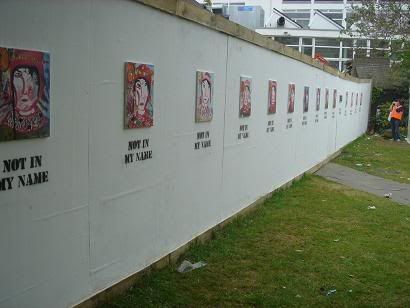 The Guilt MirrorsNot In My Name
The Guilt MirrorsNot In My NameOil and acrylic and spraypaint on canvas on board, 2007
“No more brushes, no more painting, no more eye, no more hand, no more play of materials, no more feeling, no more personality! No wonder the adepts of traditional art are terrified…”
Otto HahnOkay. i’m going to start with something uncharacteristically thoughtful, so don’t get used to it. But i’m going to let you in on a little secret. It is, after all, not what you know, it’s who you know. And, erm, it’s also what you know.
But ‘Not In My Name’ the prototype art piece by then-fledgling collective The Guilt Mirrors, was just one massive in-joke. i know you’re not so surprised. The art world trades in in-jokes before money even comes into the equation. And thank heavens for that. Granted, having entire swathes of popular culture based on comments only a chosen few will find amusing, or at least know why it could be potentially amusing in the first place, may come across as too elitist for some to bear, but would it be better any other way? Everyone knows why the chicken crossed the road, and nobody laughs at that anymore. If the chicken was sprinting across the road, clucking in fear, trying to escape from
Sarah Lucas in just her knickers, now
that’s funny.
As it happens, i’m not going to go into the reasons that deeply. We can’t give away everything at once. But let’s just say there was a painting we found attributed to us. And if you knew our thoughts about painting – or rather, the sort of painting this was, saying nothing and saying it unbeautifully – you’d probably assume it was some prankster trying to rub us up the wrong way too.

But the way we see it is that if you’re given automatic authorship of something, why deny it? If it doesn’t say what you want, change the meaning or speak for it before it gets chance to disagree with you. And if you don’t like the way it’s painted, paint it again. And again. And again. And again.
And again, and again.
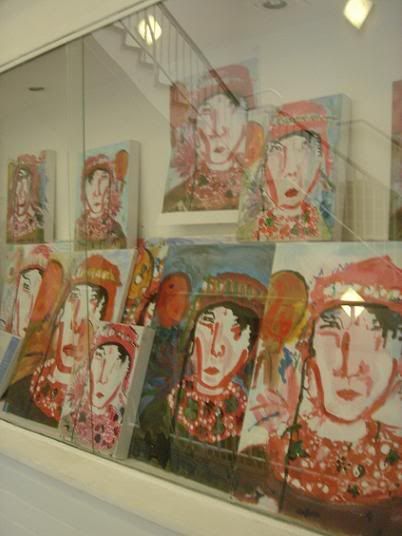
All we needed to make sure the world knew this painting was now ours was the location to exhibit our new prize. And luckily there was a large blank white public space just about to open it self up for us. With a little…
persuasion, of course.
Paint (Over) A Vulgar Picture The Thomas Ferguson BandLove Tore Us Apart
The Thomas Ferguson BandLove Tore Us ApartMicrosoft Painting of emulsion on acrylic on board, 2007
Early in this year’s spring a painted mural appeared in the public courtyard of the University of Brighton. It was in effect the lyrics to the chorus of
Joy Division’s ‘Love Will Tear Us Apart’, the eight foot high letters fashioned in a hybrid of hip hop’s early graffito stylisations and the Sixties’ flower power vibrancy, replete with flowers and hearts and cartoon animals. It took the most celebrated lyrics written by one of England’s most revered musical poets and turned them into a colourful message of optimism, exuberance and hope. It had to be destroyed.
i know, i know, it might have been a heightened form of irony that we just didn’t get, that their plan was to provoke the sort of rage that we felt bubbling up in us at the mere sight of this monstrosity, and if so then their work was completely successful. And yes, maybe if we were in the same situation and a group of people took a disliking to our work, we’d rather they said something to our face than completely obliterate the offending art piece. But neither of these points deter from how absolutely horrible having to walk past this pile of shit was every day, and luckily with freedom of expression comes freedom of suppression. My first instinct was to find a tailor’s dummy, dress it up as Ian Curtis, skewer it on a spit and attach a motor that made the figure rotate as fast as possible, titling it
Spinning In His Grave; bad taste i know, but i’d say reducing one of Curtis’ most forlorn, heartbreaking and emotionally invested lyrics and reducing them to the sort of babblings Barney The Big Fucking Purple Dinosaur would come up with – in, one presumes, an attempt to look sensitive yet fun to be with – isn’t particularly good taste either. And anyway, you don’t fight bad art with bad taste. You fight bad art with good planning.
[Aside: you know what my main problem with it was? Dead rock stars. People say that as a rock star killing yourself would be the best career move you could make. Seeing as there are still people about saying this sort of insufferable bollocks then presumably they’ve not attempted it in their own chosen field of work, but how would it help? Yes, in terms of income it could likely see your sales skyrocket, but what the hell are you going to spend the profits on, coffin polish? In terms of retaining any semblance of artistic credibility, there’s very little you could do worse. Because a dead rock star can’t scream out ‘no’ when the executives arrive to bugger the corpse. A dead rock star can’t grimace when businessmen are paying two hundred dollars a pop to stare at your rotting remains. And most of all, a dead rock star will never just be a rock star anymore; they’ll be a saint we didn’t listen to enough when they were walking the earth. The only bigger example than Curtis over the past few decades is Cobain, and, likewise, we don’t see Nirvana The Excellent Rock Band anymore, we see Kurt Cobain, Martyr For The Last Blank Generation, And The Kurt Cobain Experience. And with Ian we don’t see Joy Division anymore, we don’t see Good Indie Band With Great Frontman, we see Almighty Prophet Of Urban Decay And New Order Without Programming. And how inhumane and logically moronic is it to say that Curtis killed himself to help the band’s American tour? i doubt someone as plagued by demons as he was would kill themselves to become the messianic figurehead that a lot of people regard him as now, let alone shift some extra units. i doubt that he hung himself relieved in the knowledge that
Anton Corbijn will shoot your portrait being carried by monks across the desert in tribute…well maybe he did. i can’t really speak for him. But i bet he didn’t want a load of art students painting your words in a pithy act of hollow pseudo-rebellion to try and make them look hip. Anyway.]
So, one Wednesday, we got our rollers out.
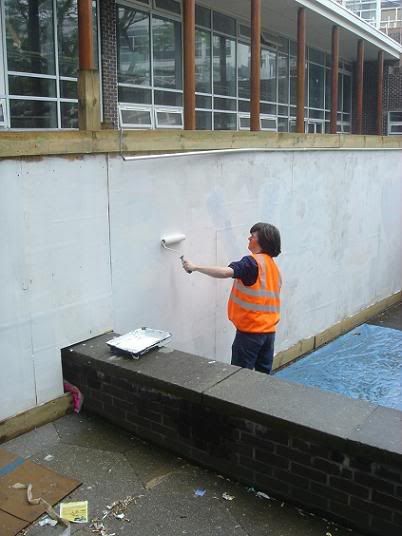
 column inches & The Thomas Ferguson BandThe Denial Twist
column inches & The Thomas Ferguson BandThe Denial Twist (excerpt)
Performance with emulsion, 2007
Graffiti that’s been painted over fascinates me. You’ll see it across subways, near bus stops, in parks, anywhere where the wall is rigorously policed, blocks of colour shielding our eyes from the chaos underneath, usually in large rectangular shapes in a different shade to the wall itself. It’s like Rothko took on Basquiat on the streets and Rothko won. Yet it’s usually just an excuse for the initial perpetrators to use their newer, if not entirely blank, concrete canvas. In Brighton though, it’s different: buildings are plastered with urban daubing, mostly at a professional level though, none of your crudely-executed ejaculating penises or ‘Happy’s Got Pox’ or, lord forbid,
this sort of thing. Say what you want, as long as we agree, and say it where we let you. Brighton as a counter-culture city has a very false, even shallow, kind of radicalism pumping through it.
So how do you become the dissenter when everyone else is pretending to be the rebel? Simple: become the authority figure. As gallery owner Tom Trevatt points out, “by seemingly negating the expressive, ‘free’ act of writing on the wall you are expressing an even greater freedom”. As
The Chapman Brothers duly recognised years ago, mutilating the work of another used to be the last true taboo in art; completely denying its existence is the next, furthest step. So we painted over it and we painted over it good. Five coats, in front of the public, and nobody stopped us.
Appropriation (By Any Other Name)“Social art is not a matter of multiplication and dissemination. Painting is not a magic lantern.”
Hélène ParmelinBy this point we’d amassed a startling number of counterfeit copies of the original. However, they were no longer counterfeits. If anything they were all the original work and the offending portrait we’d copied – sorry, appropriated – from was now the faker. This was work we had claimed as our own and now we needed to show it. One idea was to keep painting and have so many different versions of the work that they would fill an entire wall, salon-style, but we needed to act now before our virginally-white wall was scrawled over by another oh-so righteous scamp. So, we chose the choicest versions and put them up in rows, in the contemporary white cube style, above the sprayed slogan ‘NOT IN MY NAME’. Because after all, despite re-owning this picture, it was still an attempt against our integrity. It was still, in trying to fob itself off as being of our creation, trying to blame us. And luckily, it rained. With most of the paint being water-based, they dripped and flowed all over the wall, some say like melting, some say like clinging to the wall for survival, but we prefer like weeping. Yes, definitely like weeping.
The wall was knocked down a week later. We are free now.
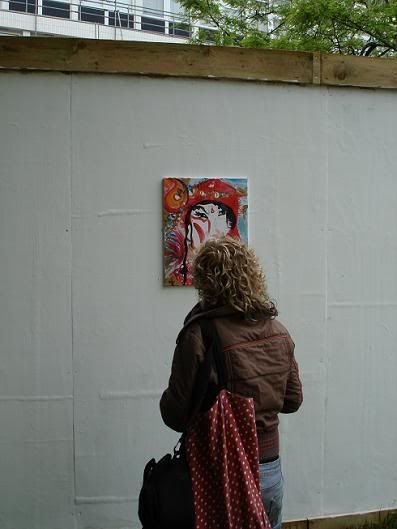

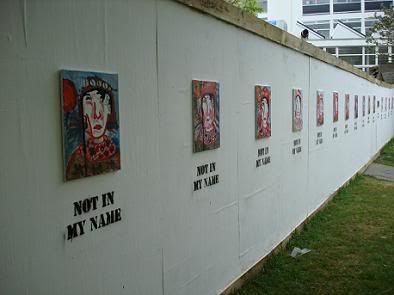 See more photos...
See more photos...








